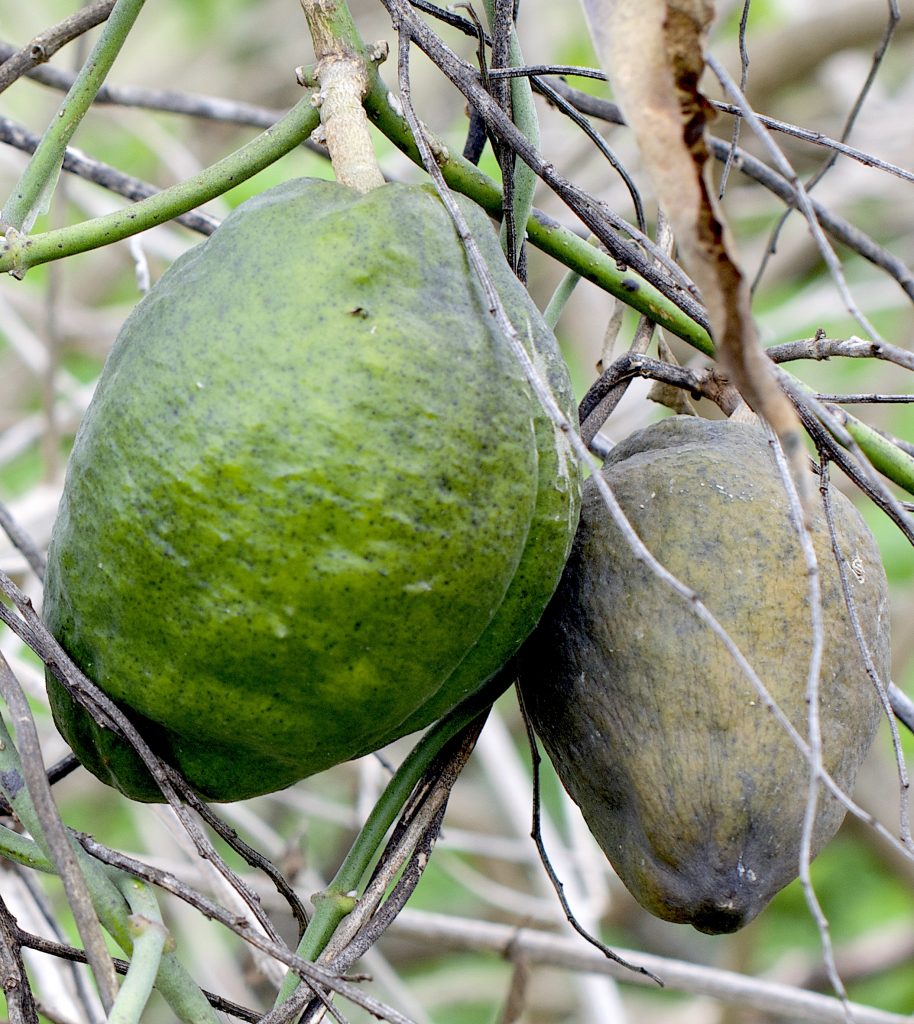
Young and old fruit of the Latex Strangler Vine. Photo by Green Deane
Millions of dollars and many decades have been spent trying to eradicate the edible pictured above. I do my part by eating as much as I can. The Latex Strangler Vine, also known as the Milkweed Vine, is on the state’s noxious weed list because it shades citrus trees to death especially in southern end of Florida. The seed pod is a staple food in its native South America and is more nutritious than the citrus it kills. We saw it during our foraging class Sunday in Largo.
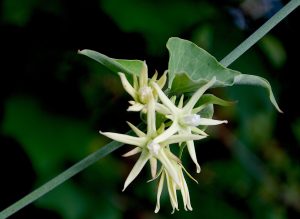
The vine’s blossoms are quite distinctive. Photo by Green Deane
In warm climates the vine will fruit all year making it a reliable source of food but also hard to control. As a tropical it does not like winter or even cool weather. But, I’ve harvested this vegetable for many years even in comparatively chilly Ocala. Even though Ocala is a “northern” location the vine — actually a liana — has picked the perfect spot to grow. There’s a large cement-block building nearby that can radiate heat at night if needed. And the vine is under a huge Live Oak, the kind that has graceful branches touching the ground great distances from the trunk. Where the branches touch the ground doesn’t get mowed well. So the vine escapes getting mowed, is protected during most freezes, and has a large tree to climb on (it can wend its way up 100 feet.) From the top of the tree it gets all the sun it needs, develops pods then drops them under the tree to reseed and repeat the cycle every year. In Largo, were it can get chilly, the vine is growing lakeside which moderates temperatures. Besides the cooked pods the fragrant flowers and leaves are also edible. To read more about the Latex Strangler Vine, go here.
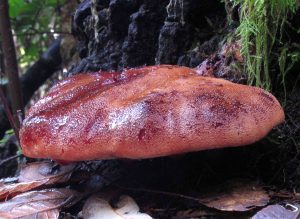
Beefsteak Polypore, Fistulina hepatica.
The Beefsteak Polypore should have been called the Raw Liver Polypore. “Polypore” means many pores and this edible mushroom has many slightly strange pores: They are all separate, little tubes, not holes as many polypores are but a huge bunch of little tubes (think small straws tied in a bundle.) The mushroom can giggle like raw liver and even spills a red juice when cut. But there the comparisons end, almost. It’s white streaked flesh can be cut like liver but it does not taste like liver. Its flavor is more on the acidic side and blends in well with dishes made with lemons. And while current advice is no to eat any mushrooms raw — including those you buy in the grocery store — this is one fungus that is consumed raw, with or without pores. The prohibition against raw mushrooms arises from two characteristics. One is the polysaccharide chitin or in this case mycochitin. Some people have the enzyme to digest it, some don’t. Undigested chitin can cause unpleasant digestive upset. The other issue is many raw mushrooms tend to have hydrazines, a class of chemicals known to cause cancer. Cooking drives off the hydrazines. And more than a few mushroom … ah… hunters have gotten nematodes from eating raw mild-altering mushrooms growing in manure. Cook your mushrooms. Indeed, some of the most prized of wild mushrooms will make you ill if consumed raw including Morels, Chanterelles, Oysters, and King Boletes.
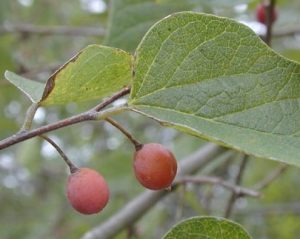
Hackberries, or sugarberries, are usually burnt orange in color.
This is a good time to identify sugarberry trees, also called hackberries. They have four fairly easy characteristics to look for. Sugarberries can be large trees usually growing near water but not in it. This is not a species you will find on the top of a hill unless there is a lake or spring there or good irrigation. It’s usually found in the company of sweet gums, pecans, ash, cedars and what is left of elms (whose family it is in.) The bark of older trees is very warty but no thorns. Sugarberry leaves usually have uneven shoulders and if you flip the leaf over there are thee main veins at the base. And this time of year you will see small pea-sized green berries on the branches. These will turn yellow to burnt orange in color in a couple of months, sometimes even darker towards purple. They are sweet with a large seed. The entire fruit is edible though the seed is on the hard side. Natives often mashed the entire fruit making them into small cakes to be eaten raw or cooked. You can read about the sugarberry here.

Foraging classes are held rain or shine, heat or cold.
Last Sunday’s class in Largo, Florida, what quite productive. We saw ripe wild grapes along with ripe Peppervine berries. Peppervine fruit is generally considered not edible but they were conveniently place to contrast and compare with edible grapes. This coming Saturday’s foraging class is in Port Charlotte, always a pleasure because it’s where the Peace River meets the Gulf of Mexico. Sunday’s class in in Lake Woodruff Preserve in Deleon Springs, FL. That’s a long hot class with one port-o-lt for a bathroom. Dress for the occasion and bring drinking water. We’ll do a loop around the wetlands then look at some upland plants.
Also notice in the foraging class line up a class in South Carolina the end of August. I’m in the Carolinas that week studying plants. Putney Farm has offered to let me hold a class there. Fee for the class is a donation to the farm in the amount of your choice.
Saturday, July 21st, Bayshore Live Oak Park, Port Charlotte, Fl. 9 a.m. Meet at the parking lot at the intersection of Bayshore Road and Ganyard Street.
Sunday July 22nd, Lake Woodruff National Wildlife Refuge, 2045 Mud Lake Road, DeLeon Springs, FL. 9 a.m. Meet at the parking lot on right after crossing the railroad tracks. It will be a long, and hot class. Bring water. Bathrooms are port-O-lets.
Saturday, July 28th, Florida State College, south campus, 11901 Beach Blvd., Jacksonville, 32246. We will meet at building “D” next to the administration parking lot. 9 a.m.
Sunday, July 29th, Venetian Gardens, 201 E. Dixie Ave, Leesburg, FL 34748. 9 a.m. Meet at the parking lot near the pool.
Saturday, August 4th, Blanchard Park, 10501 Jay Blanchard Trail, Orlando, FL 32817. 9 a.m. Meet at the pavilion east of the tennis courts near the YMCA.
Sunday, August 5th, Boulware Springs Park, 3420 SE 15th St., Gainesville, FL 32641. Meet at the picnic tables next to the pump house. 9 a.m.
Saturday, August 11th, Dreher Park, 1200 Southern Blvd., West Palm Beach, 33405. As this is the hot summer time do you want to meet at 8 a.m.? Just north of the science center.
Monday, August 27th, 1624 Taylor Road, Honea Path, South Carolina. Ever want to meet Green Deane but he never seems to come to your neck of the woods? Then mark Monday, August 27th, on your calendar. Green Deane will have a free foraging class in Honea Path, South Carolina, at the Putney Farm, 1624 Taylor Road. The foraging begins at 10 a.m., rain or shine (except hurricanes.) All of Green Deane’s classes are hands on, walking outside. Wild edible plants, medicinals and perhaps a mushroom or two will be on the agenda (as Green Deane is in the Carolinas that week studying local mushrooms.) Donations to Putney Farm are appreciated as they are hosting the event. For more information you can contact Putney Farm on Facebook or Green Deane at GreenDeane@gmail.com.
For more information about the classes go here.
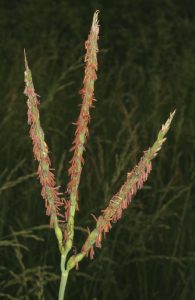
Eastern Gammagrass in blossom.
Grass and ice cream are usually not considered at the same time unless it is Eastern Gamagrass. Why? Because livestock like the clumping Tripsacinae so much cattlemen call in Ice Cream Grass. While it can be used like wheat it’s a distant relative of corn. Eastern Gamagrass is sod forming and can reach up to eight-feet tall. Though it is pollinating now locally the grass can seed from June to September. As you can tell from photo to the right the male flowers occupy the top three-fourths of the spike and the female flowers the bottom fourth. In this species the girls are brown, hair-like structures. Besides fodder Eastern Gamagrass is a common ornamental found in parks and residential areas. A bunch can live to be 50 years old or more To read more about Eastern Gamagrass go here.
From one point of view Purslane is a very easy topic: It’s edible, nutritious, and fairly easy to identify. It is sold in supermarkets around the world except the United States, so you have to find your own which is easy because it grows everywhere. From there things get complicated.
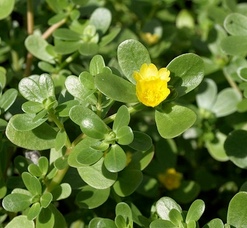
Common Edible Purslane
What about ornamental purslanes, the kind you find for bedding plants in home improvement stores? They often have colors other than yellow, such as orange and flamingo and the like. Their blossoms can be doubled or frilly. Then there are native members of the genus, Portulaca: Are they edible? Somewhere back in the early 90’s I asked Forager Emeritus Dick Deuerling if ornamental purslanes were edible. He said he didn’t know and wasn’t interested in finding out. Some 20 years later that is my answer. I don’t know. My suspicion is if they are not they are not severely toxic. That leads me to our local native Portulaca pilosa. I have tried it. The leaves burn my mouth a little and upset my stomach some. Nothing horrible but nothing I want to repeat. I’ve had some beginning foragers tell me they eat it but I have not had any experienced foragers tell me that. You can read about purslane here. Also do not eat any plant that looks like purslane but has white sap. They are not edible.

Green Deane Forum
Want to identify a plant? Need to identify a plant? Looking for a foraging reference? Maybe you have a UFO, an Unidentified Flowering Object, you want identified. On the Green Deane Forum we — including Green Deane — chat about foraging all year. And it’s not just about warm-weather plants or just North American flora. Many nations share common weeds so there’s a lot to talk about. There’s also more than weeds. The reference section has information for foraging around the world. There are articles on food preservation, and forgotten skills from making bows to fermenting food. Topics have included: Tea, Salt and Amla, Small Bush and Flower, Ragweed? Pine Cough Drops and Needles, Odd Vine? Hunting and Trapping Ethics. Knife Accidents. Some Kind of Lespendeza and Survival Garden. You can join the forum by clicking on the button in the menu line.

Green Deane DVD set of 135 videos
All of Green Deane’s videos available for free on You Tube. They do have ads on them so every time you watch a Green Deane video I get a quarter of one cent. Four views, one cent. Not exactly a large money-maker but it helps pays for this newsletter. If you want to see the videos without ads and some in slightly better quality you can order the DVD set. It is nine DVDs with 15 videos on each. Many people want their own copy of the videos or they have a slow service and its easier to order then to watch them on-line. They make a good gift for that forager you know. Individual DVDs can also be ordered. You can order them by clicking on the button on the top right of this page or you can go here.
This is weekly issue 313.
If you would like to donate to Eat The Weeds please click here. Or you can use my Go Fund Me link, or by writing to Green Deane POB 941793 Maitland FL, 32794.
Lawns Aren’t Green
I saw two advertising headlines on trucks that caught my attention. One was a flat bed for a company that paves driveways in Tampa. The clever sign said: “If your driveway’s crack it’s not our asphalt.” Good marketing but one suspects driveway stones that let rainwater though and don’t leach bad chemicals would be a better choice. The other truck was lawn maintenance. Its sign was more to the point: “If you grow it we mow it.”
 The first thought that crossed my mind was why do people grow lawns? I might even go as far as to ask why do men grow so much grass since they do most of the home lawn keeping in the United States. Historically men have been the tamers of the wilderness which lawns might represent. When you add power tools and things you can ride, we might have part of an answer: Lawns are modern wilderness men have to tame. One friend said that when he’s done taking care of his lawn he feels a sense of accomplishment. He can see a difference, a job well done. He can see and measure his success. I have a neighbor who has at best a thousand square feet of lawn total. He has a huge riding mower, a chipper, blower, hedge trimmer, edge trimmer and lawn vacuum. Nearly every Sunday his entire day is spent manicuring his small patch of grass. Another neighbor is trying to keep a lawn like a putting green. Indeed, I know two people who mow their lawn every day: Every day! Maybe lawns are maintained because they are there. As I have said before, trees earn their keep, lawns have to be kept. Perhaps the key to change is stop building new homes with lawns.
The first thought that crossed my mind was why do people grow lawns? I might even go as far as to ask why do men grow so much grass since they do most of the home lawn keeping in the United States. Historically men have been the tamers of the wilderness which lawns might represent. When you add power tools and things you can ride, we might have part of an answer: Lawns are modern wilderness men have to tame. One friend said that when he’s done taking care of his lawn he feels a sense of accomplishment. He can see a difference, a job well done. He can see and measure his success. I have a neighbor who has at best a thousand square feet of lawn total. He has a huge riding mower, a chipper, blower, hedge trimmer, edge trimmer and lawn vacuum. Nearly every Sunday his entire day is spent manicuring his small patch of grass. Another neighbor is trying to keep a lawn like a putting green. Indeed, I know two people who mow their lawn every day: Every day! Maybe lawns are maintained because they are there. As I have said before, trees earn their keep, lawns have to be kept. Perhaps the key to change is stop building new homes with lawns.
Lawn grass is the second-largest crop in the United States after another grass, corn (and I suspect if corn was not subsidized by the government lawn grass would be the largest crop.) Sixty percent of drinkable water in suburbia goes to watering lawns. Home owners also use 10 times more pesticides and fertilizer than they need to maintain their lawn (and far more than farmers use.) A lot of folks worry about the impact of Big Agriculture on the environment. What about the environmental impact of Big Lawn? Besides excess use of pesticides and fertilizer millions of gallons of gasoline and oil are accidentally spilt every year while working with those lawn-related power tools. Lawns just aren’t green. One can envision a transition over many years: First new homes without lawns being added then a lawn tax for those who must keep them. That will happen when politicians realize it is a new source of income.
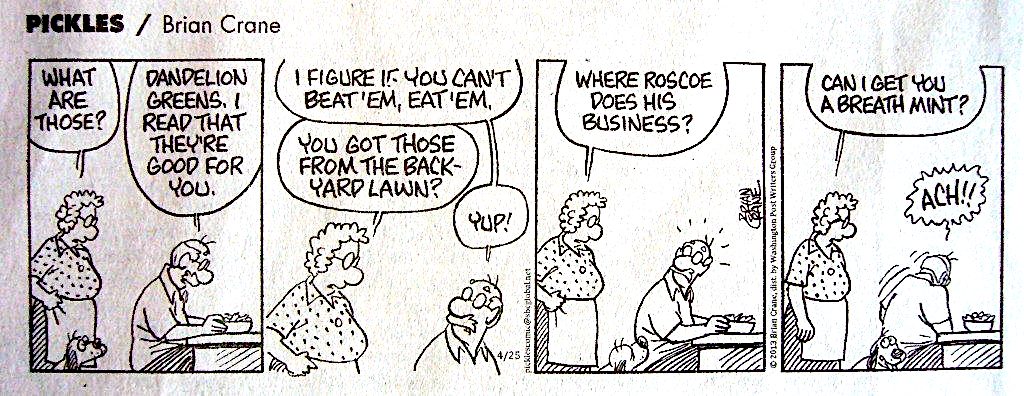


Hi Green Deane,
Does drying mushrooms before consuming mitigate any of the mentioned risks associated with raw mushrooms? Or should be just be safe and always saute (or boil or bake…)?
Thanks!
Hayley
I found some purslane from two different locations, brought them home on two separate occasions and planted them side by side. Since they’ve been growing for a while, I notice they are quite different. One is more compact and has a red stem, the other larger and more sprawling with a light green stem. Plan to do a taste test soon but hope they are equally edible.
I’m interested in the fragance of the flowers of the Strangler Milkweed vine . It is nice especially during cold morning here in my area. One thing I notice is that the mature fruit after drying it explodes to disperse the seeds which fly in the air.
They changed the scientific name of the Strangler Milkweed Vine, also called Latexplant to Araujia odorata.